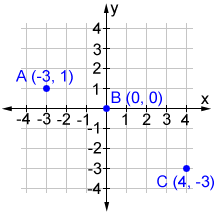Y axis
The y-axis is one of the two number lines that make up a 2D rectangular coordinate system (or one of three in a 3D coordinate system). The y-axis is almost always the vertical axis in a 2D rectangular coordinate system. The other number line in a 2D rectangular coordinate system is the x-axis.

A coordinate plane can be used to describe the position of points in space. The y-axis is used to describe the vertical position of a point. The position of a point in a 2D rectangular coordinate system is written as an ordered pair of numbers: (x, y). The second number in the pair corresponds to the vertical position of the point and is called the y-coordinate. This number tells you the vertical distance (by convention: negative = down, positive = up) and direction of the point relative to the x-axis.

Points A, B, and C are graphed on the coordinate plane above. The y-coordinate of point A is 1. Therefore, it is located above the x-axis and has a distance of 1 from the x-axis. The y-coordinate of B is 0, so it is located at the x-axis; the y-coordinate of C is -3, so it is 3 units below the x-axis.
